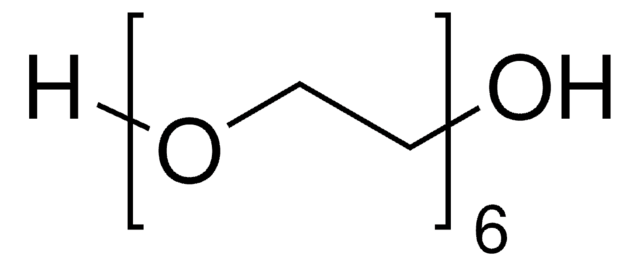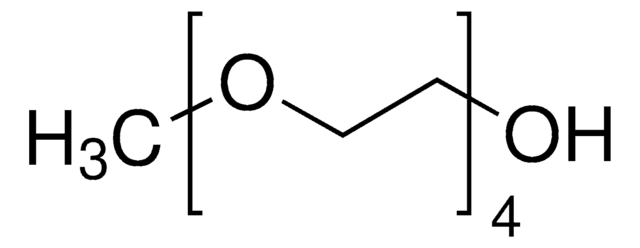335754
Pentaethylene glycol
98%, average MN 250
Synonym(s):
Polyethylene glycol, 3,6,9,12-Tetraoxatetradecane-1,14-diol, Pentaglycol
About This Item
Recommended Products
product name
Pentaethylene glycol, 98%
Assay
98%
form
liquid
mol wt
average Mn 250
refractive index
n20/D 1.462 (lit.)
bp
184 °C/2 mmHg (lit.)
density
1.126 g/mL at 25 °C (lit.)
Ω-end
hydroxyl
α-end
hydroxyl
SMILES string
OCCOCCOCCOCCOCCO
InChI
1S/C10H22O6/c11-1-3-13-5-7-15-9-10-16-8-6-14-4-2-12/h11-12H,1-10H2
InChI key
JLFNLZLINWHATN-UHFFFAOYSA-N
Looking for similar products? Visit Product Comparison Guide
Related Categories
Application
- Application of Prussian Blue in Electrochemical and Optical Sensing of Free Chlorine.: This study discusses the use of Prussian Blue on fluorine-doped tin oxide coated glass slides for electrochemical and optical sensing applications, specifically targeting free chlorine detection, highlighting its high sensitivity and stability (Valiūnienė et al., 2022).
- Evaluation of a photoelectrochemical platform based on strontium titanate, sulfur doped carbon nitride and palladium nanoparticles for detection of SARS-CoV-2 spike glycoprotein S1.: The article evaluates the integration of fluorine-doped tin oxide in a complex photoelectrochemical cell designed for the detection of COVID-19′s spike protein, underscoring its potential in rapid diagnostic applications (Botelho et al., 2022).
- Immunodiagnostic of leprosy exploiting a photoelectrochemical platform based on a recombinant peptide mimetic of a Mycobacterium leprae antigen.: This research highlights a novel use of fluorine-doped tin oxide slides in a photoelectrochemical setup for the sensitive and specific immunodiagnosis of leprosy, showcasing the material′s application in medical diagnostics (Yotsumoto Neto et al., 2019).
- Fast and reliable BIA/amperometric quantification of acetylcysteine using a nanostructured double hydroxide sensor.: This paper presents a method utilizing fluorine-doped tin oxide for the rapid and reliable electrochemical detection of acetylcysteine, demonstrating the coating′s effectiveness in enhancing electron transfer and sensitivity in biosensing applications (Correa et al., 2018).
- Nanostructured TiO2 Films Attached CdSe QDs Toward Enhanced Photoelectrochemical Performance.: Discusses the role of fluorine-doped tin oxide substrates in improving the photoelectrochemical properties of TiO2 films combined with quantum dots, which could advance the development of more efficient solar cells and sensors (Du et al., 2016).
Storage Class Code
10 - Combustible liquids
WGK
WGK 3
Flash Point(F)
235.4 °F - closed cup
Flash Point(C)
113 °C - closed cup
Personal Protective Equipment
Choose from one of the most recent versions:
Already Own This Product?
Find documentation for the products that you have recently purchased in the Document Library.
Customers Also Viewed
Articles
Progress in biotechnology fields such as tissue engineering and drug delivery is accompanied by an increasing demand for diverse functional biomaterials. One class of biomaterials that has been the subject of intense research interest is hydrogels, because they closely mimic the natural environment of cells, both chemically and physically and therefore can be used as support to grow cells. This article specifically discusses poly(ethylene glycol) (PEG) hydrogels, which are good for biological applications because they do not generally elicit an immune response. PEGs offer a readily available, easy to modify polymer for widespread use in hydrogel fabrication, including 2D and 3D scaffold for tissue culture. The degradable linkages also enable a variety of applications for release of therapeutic agents.
Devising biomaterial scaffolds that are capable of recapitulating critical aspects of the complex extracellular nature of living tissues in a threedimensional (3D) fashion is a challenging requirement in the field of tissue engineering and regenerative medicine.
Our team of scientists has experience in all areas of research including Life Science, Material Science, Chemical Synthesis, Chromatography, Analytical and many others.
Contact Technical Service












